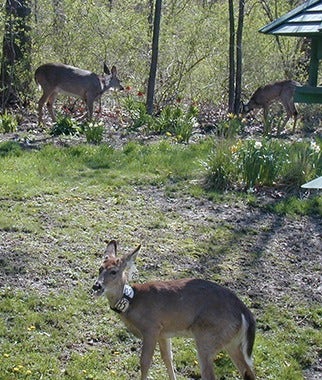We use cookies to give you the best experience on our website. These cookies are completely safe and secure and will never contain any sensitive information. Please read our Privacy Policy. By clicking "Ok" or clicking on any other content, you agree that cookies can be placed.
The Challenges of Deer
To deer, a well tended garden is a living feast. In the spring, they nibble the succulent new leaves and flowers on shrubs. They eat tulip buds and the tender shoots of emerging perennial plants. All summer long, they eat the lilies, roses, tomatoes, and beans.
In the fall, restless bucks scrape the velvety fuzz off their antlers by rubbing them hard against the trunks of small trees, stripping off bark and often smashing the trees and dashing a gardener's hopes. During the winter, hungry deer may sustain themselves on evergreens. Preventing the damage and disappointment they cause requires diligence and imagination.
Secure, high fences are the only sure way to keep deer out of a garden, but fences are expensive and may spoil the mood of a garden. Repellant sprays and smart planting strategies can make a big difference.
Deer repellants are effective, but they need your help:
- Be observant: As soon as you see tracks and or evidence that deer have nibbled on plants, it's time to spray.
- Read the label: Apply repellent according to the directions, and reapply diligently. Don't wait two months to reapply a product if the label advises applications every 30 days.
- Be realistic: Nothing is 100 percent effective. If the deer population is high and the natural food sources are low, deer will find your garden.
Deer-resistant plantings will slow them down: deer are picky eaters. They generally stay away from daffodils and alliums, and they're not particularly interested in hellebores or big, old-time moss roses, which have thorny stems and sticky buds. Deer do not relish boxwood, and they tend not to like plants with fuzzy leaves, like lamb's ear, or with fragrant foliage, like mint and lavender. They can be frustratingly unpredictable, however. One year, the deer may show a preference for pink impatiens and leave the red ones untouched. The next year, if you plant only red impatiens, they'll gobble them all. To co-exist with deer, you simply have to keep ahead of them with a smart spraying strategy and a careful choice of plants.
If deer are hungry enough, they'll eat just about anything. Nevertheless, there are some plants they do not favor. Barberry, boxwood, hollies, and Colorado blue spruce are rarely damaged by deer, and deer do not like plants with fragrant or fuzzy foliage. But lists of deer resistant plants are just a guideline: deer don't read lists.
Deer definitely have favorite foods (tulips, daylilies, and hostas are among them), and some plants they find less desirable. Here are a few deer-resistant plants:
Trees: sourwood, sweetgum, birch, catalpa, blue spruce, Russian olive.
Shrubs: barberry, boxwood, privet, fothergilla, lilac, quince, spirea.
Perennial flowers: amsonia, coneflower, penstemon, perovskia (Russian sage), yarrow, lily of the valley.
Annual flowers: nasturtium, marigold, larkspur, sunflower, snapdragon, sweet alyssum.

